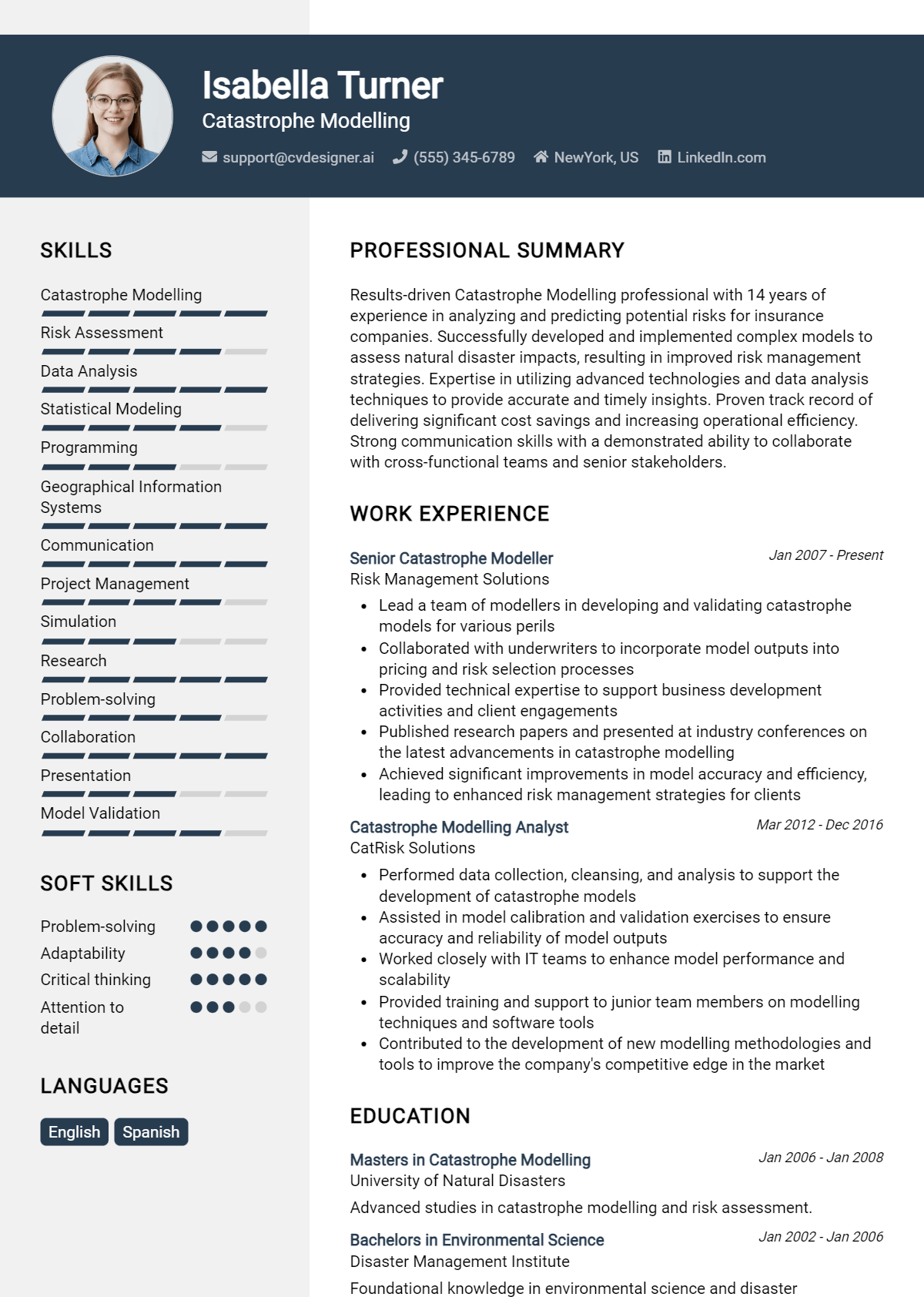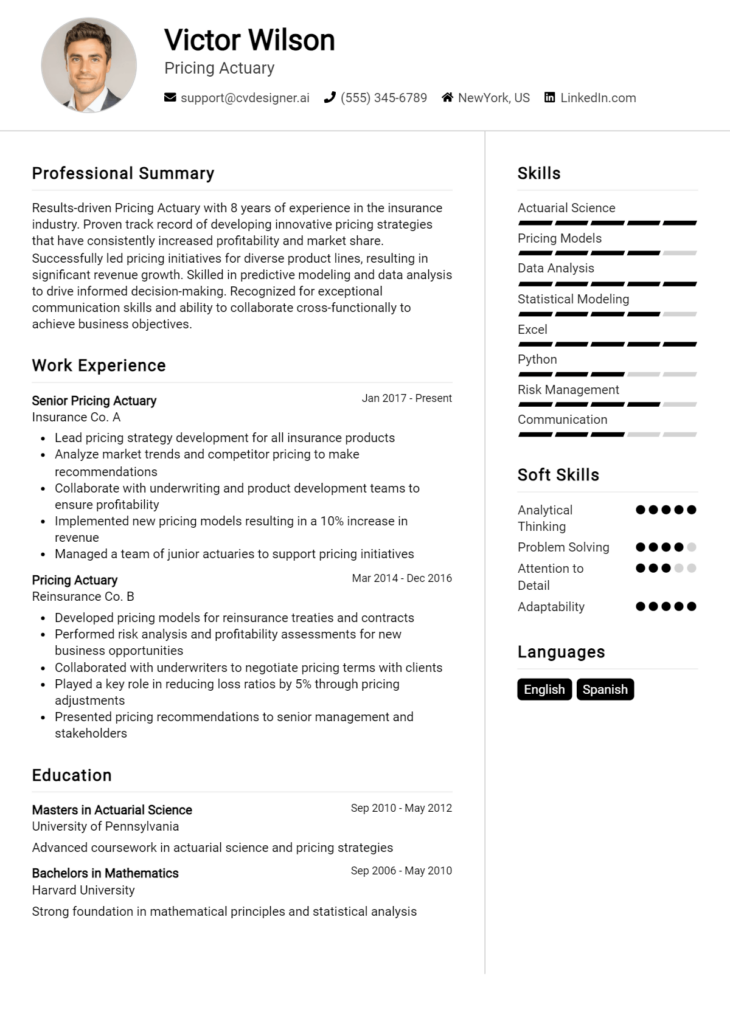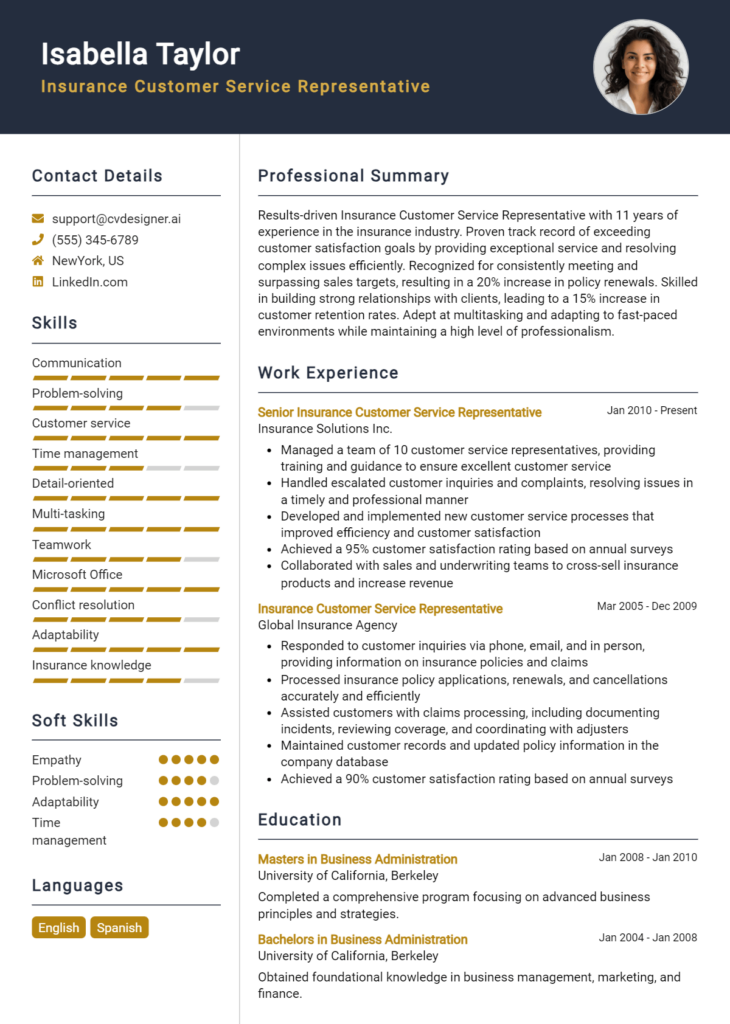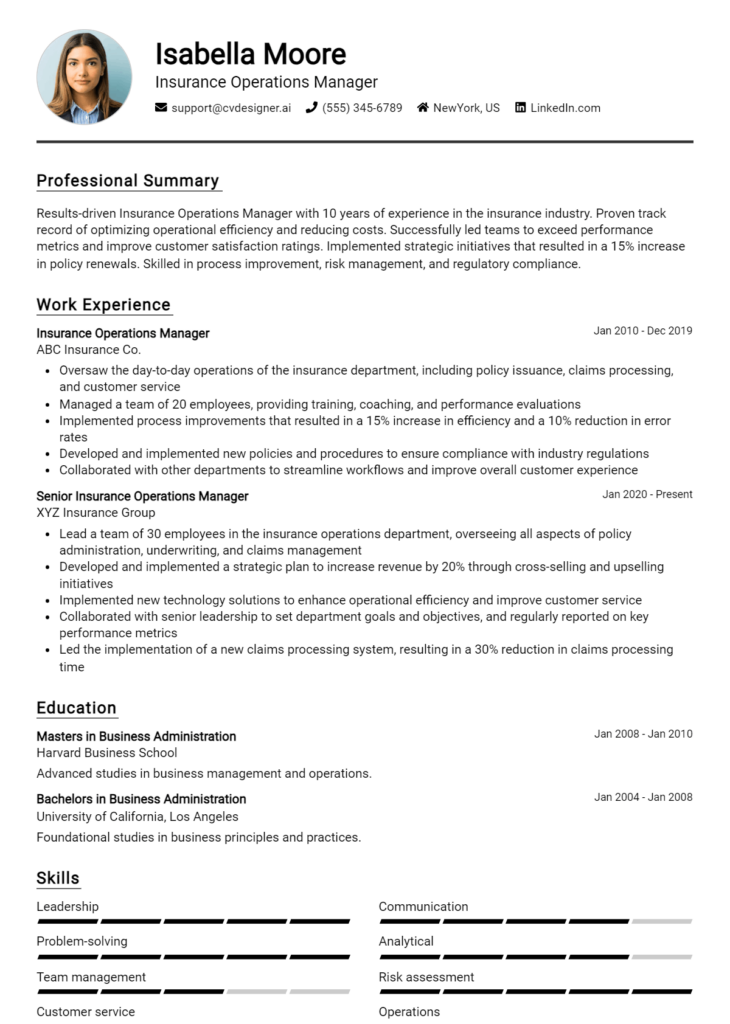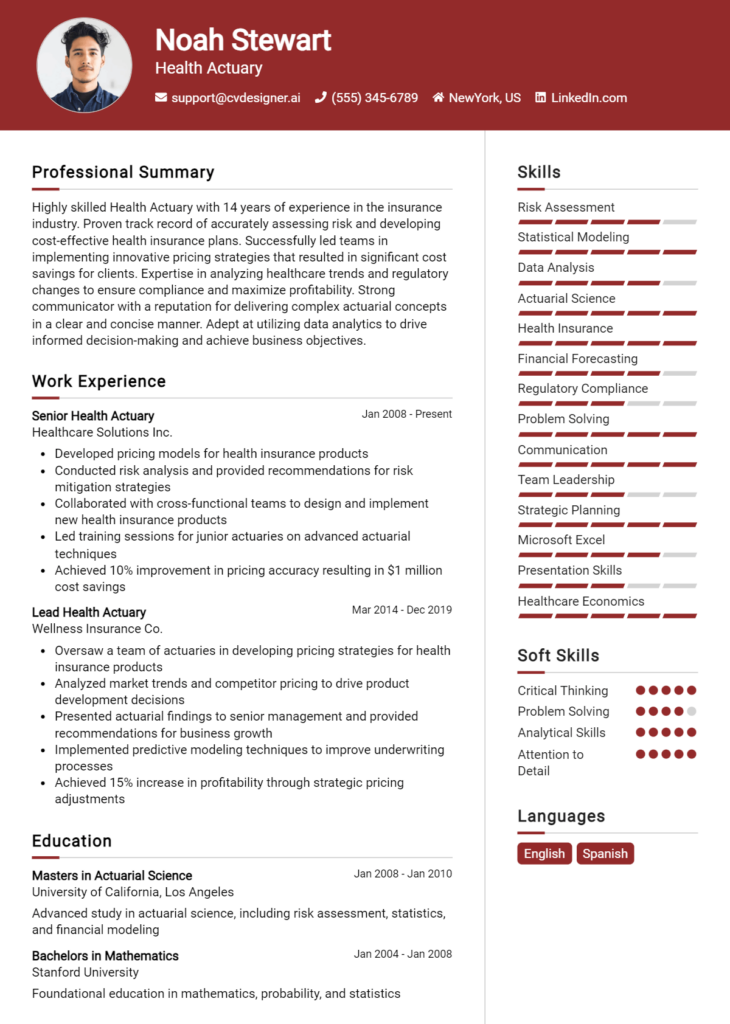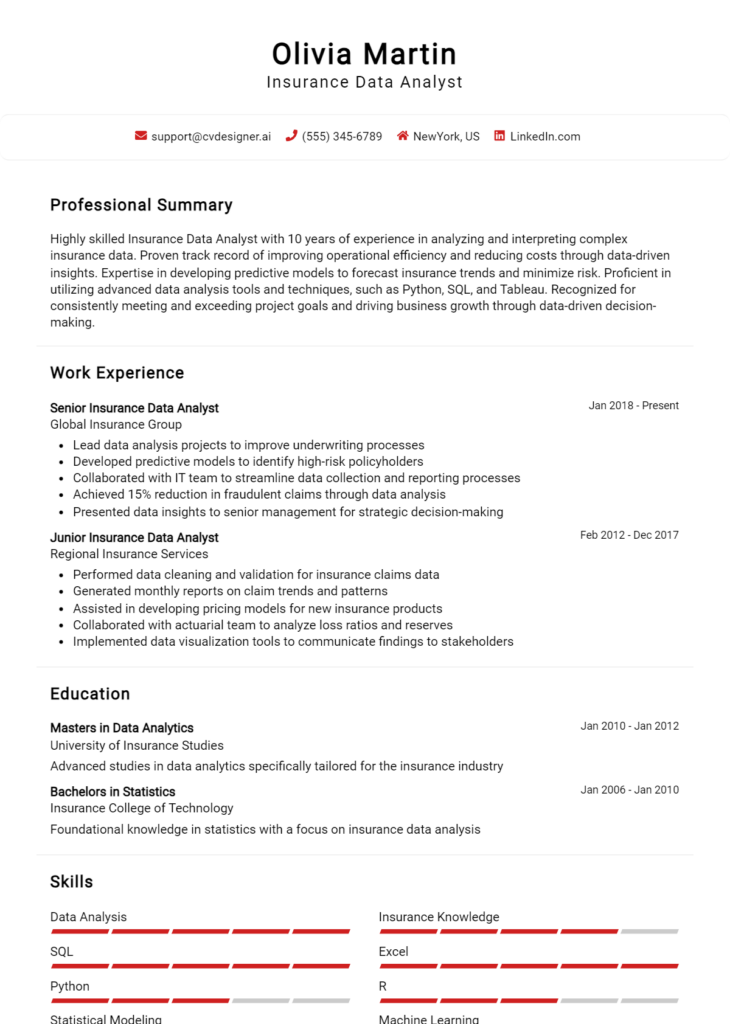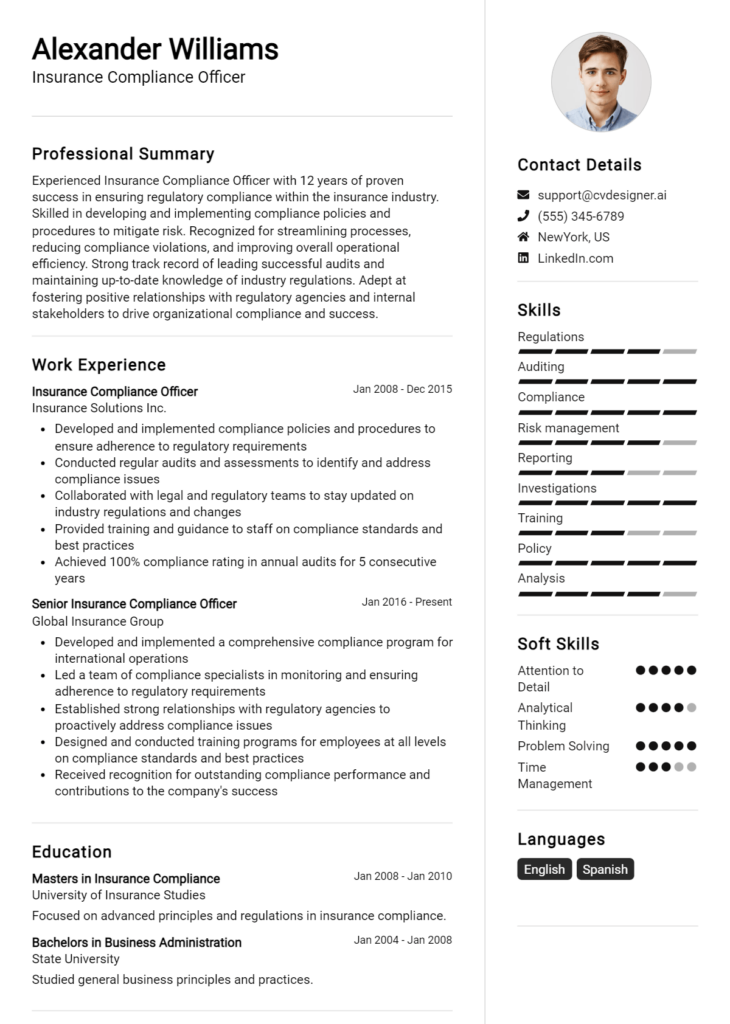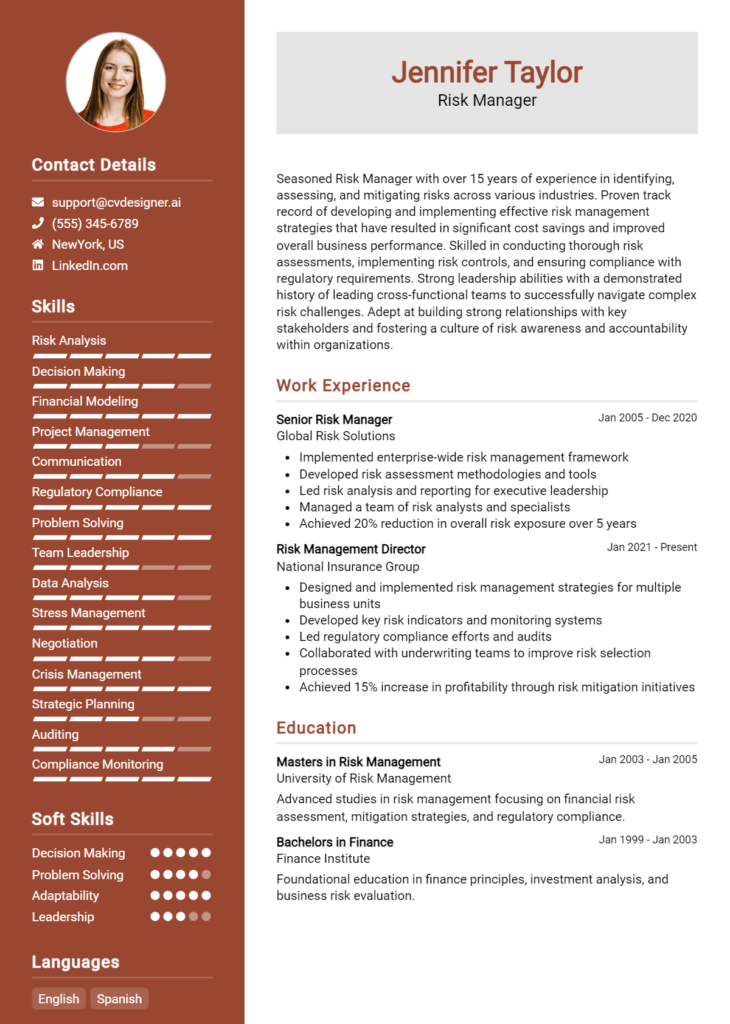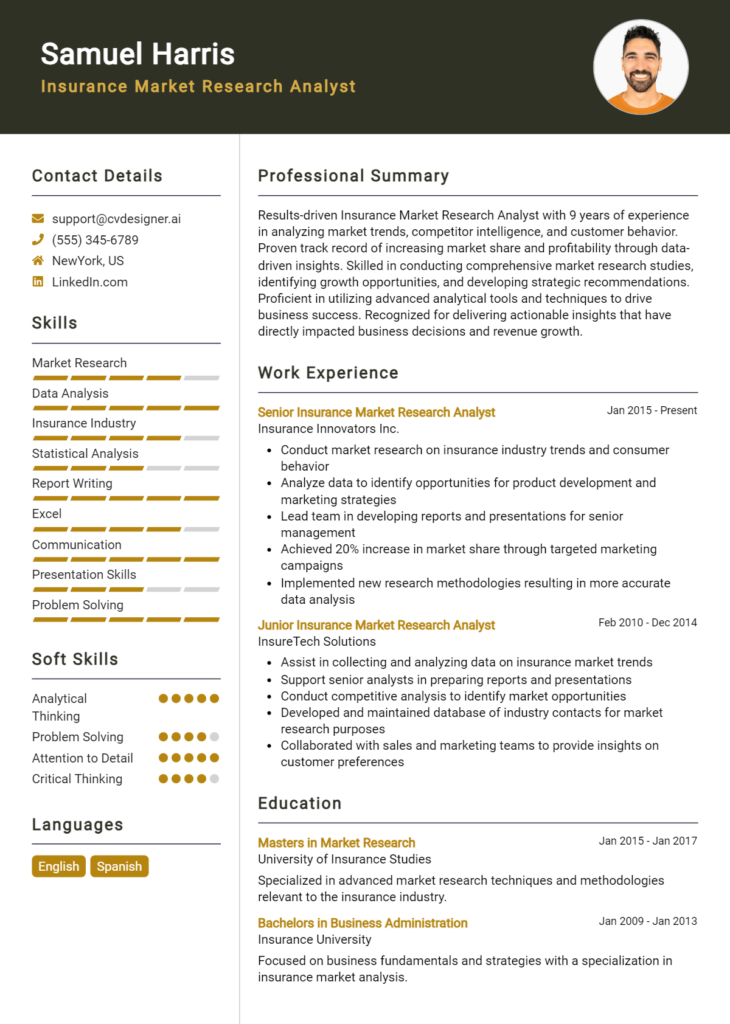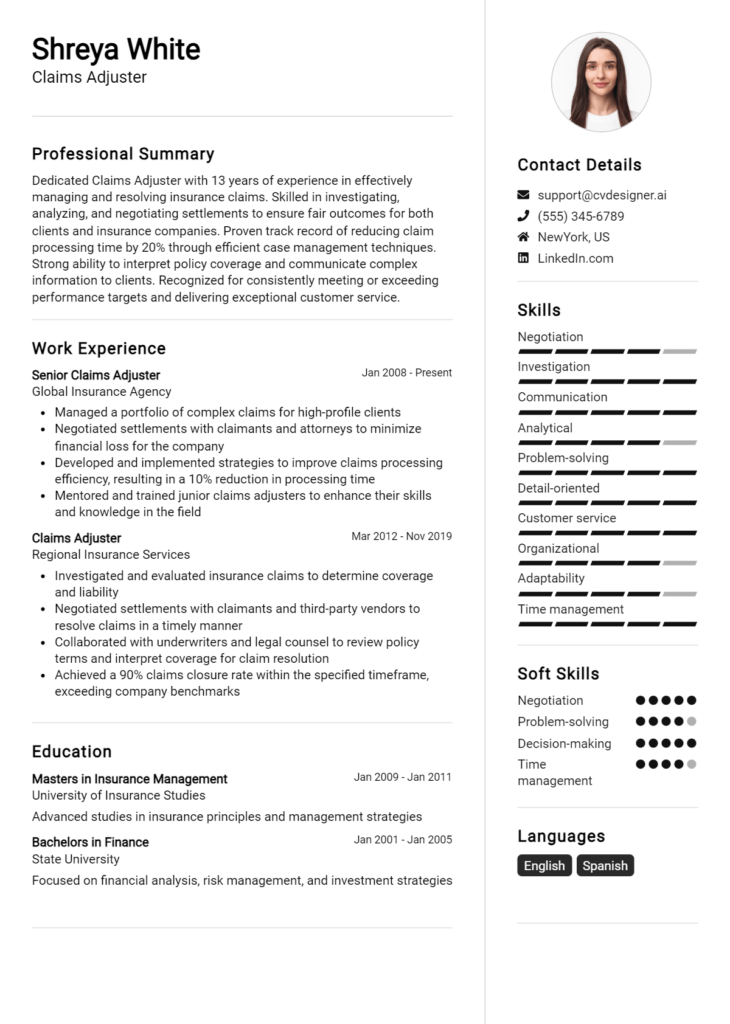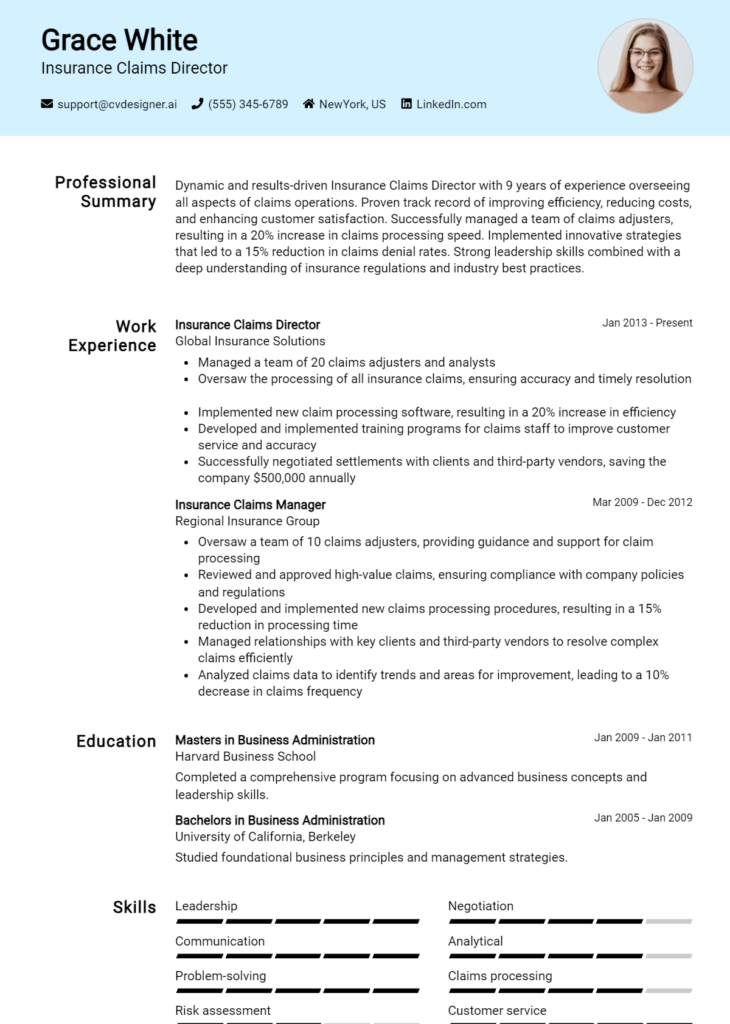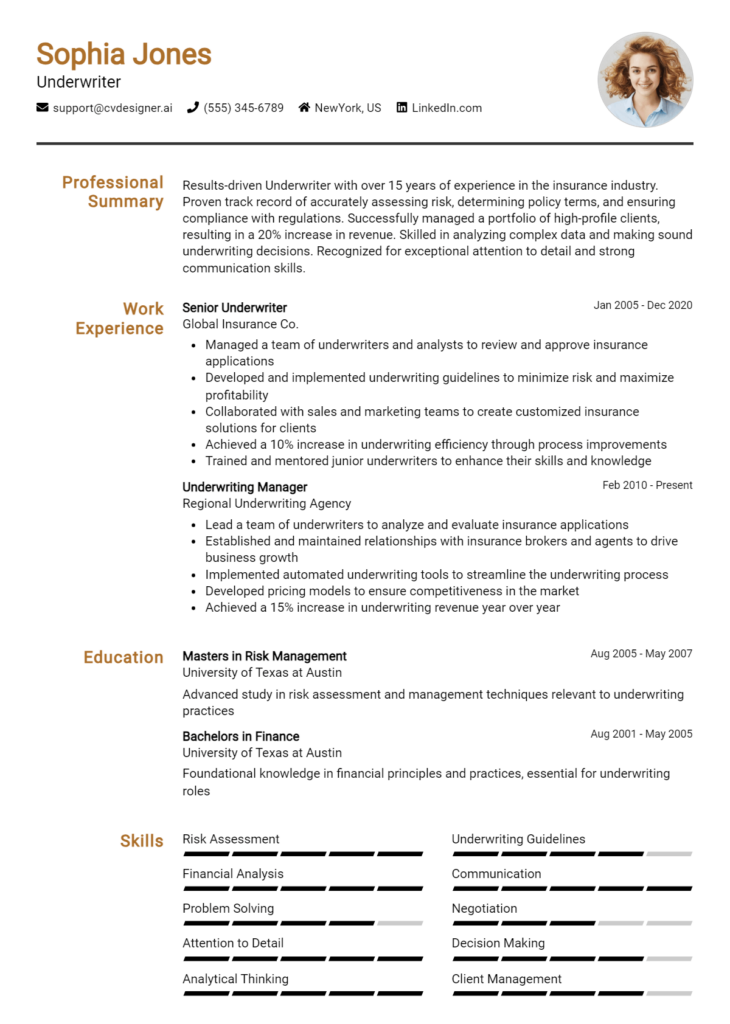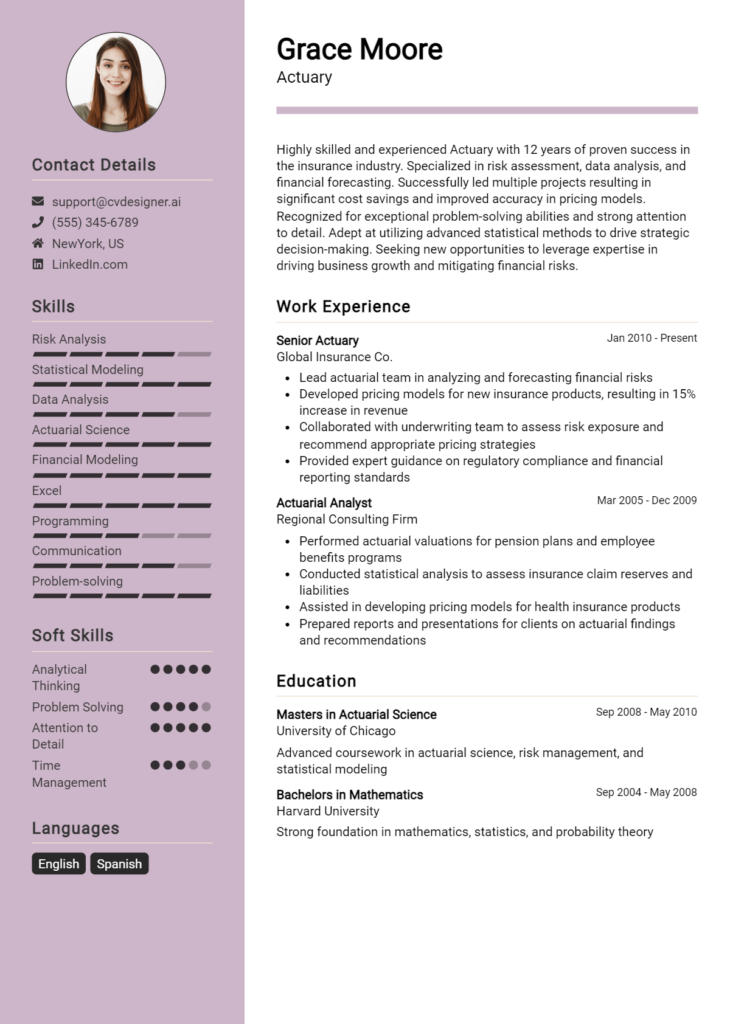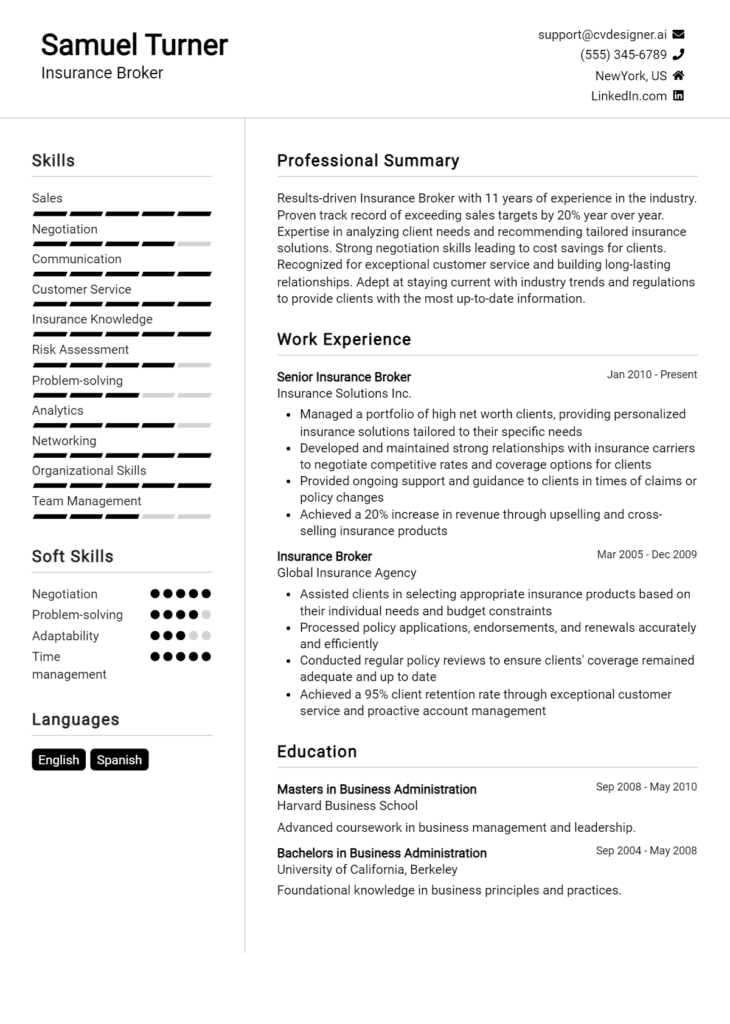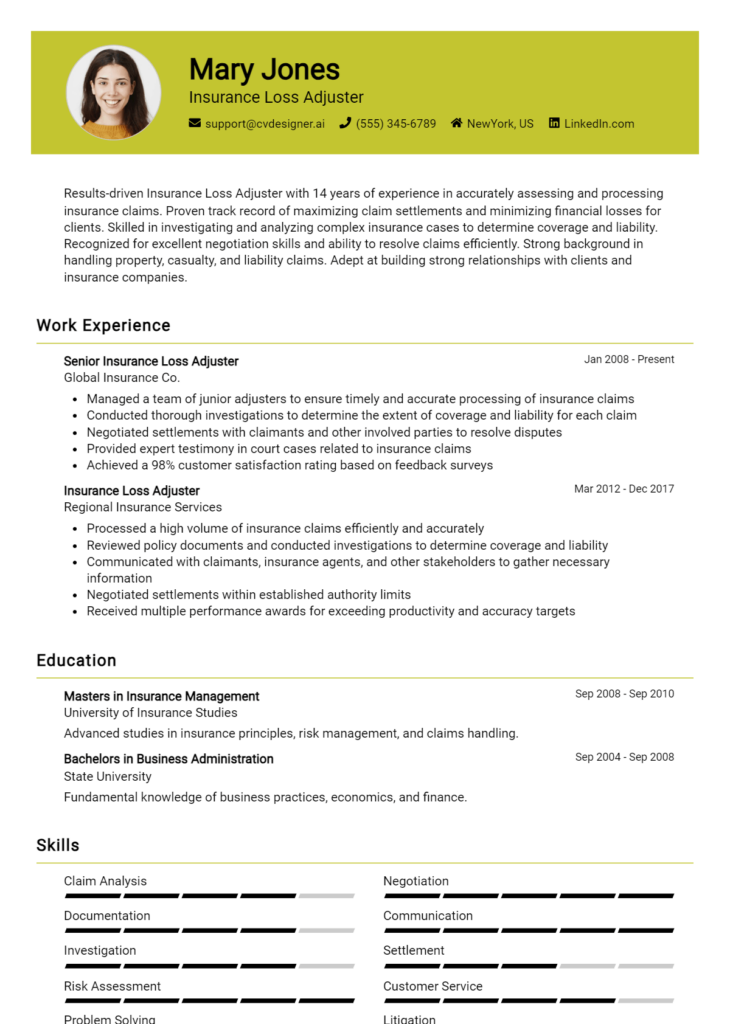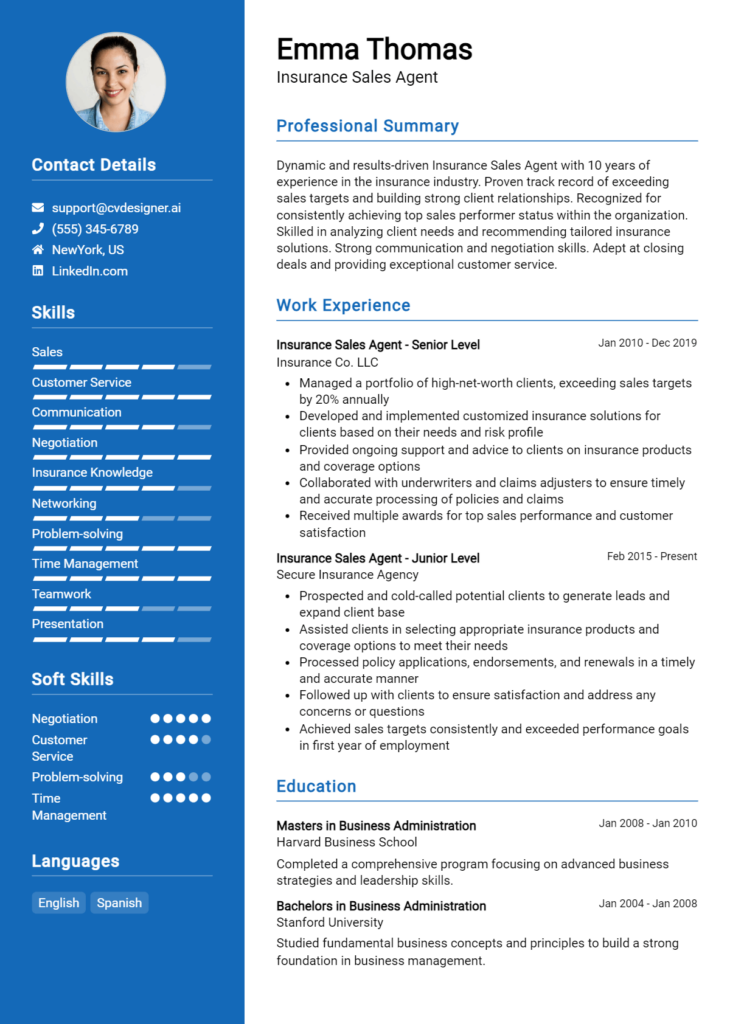Catastrophe Modelling Core Responsibilities
Catastrophe Modelling professionals play a crucial role in assessing risks associated with natural disasters, bridging various departments such as underwriting, claims, and risk management. Key responsibilities include analyzing data, developing models, and interpreting results to inform decision-making. Essential skills encompass technical expertise in statistical analysis, operational proficiency in software tools, and strong problem-solving capabilities. These competencies contribute significantly to the organization’s objectives by enabling informed risk assessments. A well-structured resume can effectively showcase these qualifications, highlighting the individual's ability to enhance organizational resilience.
Common Responsibilities Listed on Catastrophe Modelling Resume
- Conduct risk assessments for natural disasters and extreme weather events.
- Develop and maintain catastrophe models using statistical software.
- Analyze large datasets to identify potential vulnerabilities.
- Collaborate with underwriting and claims teams to inform policy decisions.
- Prepare reports and presentations to communicate findings to stakeholders.
- Monitor industry trends and regulatory changes affecting risk management.
- Validate and enhance existing catastrophe models based on new data.
- Provide technical support and training to internal teams.
- Participate in project management to implement new modelling tools.
- Identify opportunities for improving modelling processes and methodologies.
- Support strategic planning initiatives with risk insights.
High-Level Resume Tips for Catastrophe Modelling Professionals
In the competitive field of Catastrophe Modelling, a well-crafted resume serves as a crucial tool for standing out to potential employers. As the first impression a candidate makes, the resume must effectively convey not only a candidate's technical skills and expertise but also their achievements and contributions to the industry. A well-structured resume highlights a candidate's ability to analyze complex data, assess risk, and develop models that inform critical decision-making. This guide will provide practical and actionable resume tips specifically tailored for Catastrophe Modelling professionals, ensuring your application resonates with hiring managers and reflects your unique qualifications.
Top Resume Tips for Catastrophe Modelling Professionals
- Tailor your resume to the specific job description by incorporating relevant keywords and phrases used in the posting.
- Highlight your experience with industry-standard software and tools, such as RMS, AIR, or other catastrophe modelling platforms.
- Quantify your achievements with specific metrics, such as improved model accuracy percentages or the financial impact of your analyses.
- Showcase your educational background, including any relevant degrees, certifications, or ongoing professional development in risk assessment and modelling.
- Include project examples that demonstrate your ability to handle real-world catastrophe scenarios and the outcomes of your modelling efforts.
- Emphasize collaboration skills by mentioning any cross-functional teams you have worked with and your role in those projects.
- Highlight your understanding of regulatory requirements and industry standards that impact catastrophe modelling.
- Incorporate any programming skills, such as proficiency in Python, R, or SQL, which can enhance your modelling capabilities.
- Use a clean and professional format that allows for easy reading and highlights crucial information effectively.
By implementing these resume tips, Catastrophe Modelling professionals can significantly enhance their chances of landing a job in this specialized field. A tailored and well-structured resume not only showcases your technical prowess and relevant experience but also reflects your commitment to the profession, making a compelling case to potential employers.
Why Resume Headlines & Titles are Important for Catastrophe Modelling
In the field of Catastrophe Modelling, crafting an effective resume is crucial for standing out in a competitive job market. One of the key elements of a successful resume is the headline or title, which serves as the first impression for hiring managers. A strong headline immediately grabs attention and succinctly summarizes a candidate's key qualifications, making it easier for employers to identify the most suitable applicants. It should be concise, relevant, and directly related to the specific position being applied for, encapsulating the candidate's expertise in a striking phrase that resonates with the demands of the role.
Best Practices for Crafting Resume Headlines for Catastrophe Modelling
- Keep it concise: Aim for a headline that is brief yet informative, ideally one line.
- Be role-specific: Tailor the headline to reflect the specific position in Catastrophe Modelling you are applying for.
- Highlight key skills: Include relevant skills or certifications that distinguish you from other candidates.
- Use impactful language: Choose strong action verbs and descriptive adjectives to convey confidence and expertise.
- Avoid jargon: Ensure that the language is accessible to a wide audience, including non-specialist HR personnel.
- Incorporate metrics: If applicable, use quantitative data to underscore achievements (e.g., “Reduced risk assessment time by 30%”).
- Reflect your experience level: Consider including your years of experience or notable roles to provide context.
- Align with job description: Use keywords found in the job posting to make your headline more tailored and relevant.
Example Resume Headlines for Catastrophe Modelling
Strong Resume Headlines
"Experienced Catastrophe Modeller Specializing in Risk Assessment and Data Analysis"
“Certified Catastrophe Risk Analyst with 5+ Years in Predictive Modelling”
“Proven Track Record in Natural Disaster Impact Modelling and Mitigation Strategies”
“Dynamic Catastrophe Modelling Expert with Advanced Statistical Analysis Skills”
Weak Resume Headlines
“Looking for a Job in Catastrophe Modelling”
“Catastrophe Modelling Professional”
Strong resume headlines are effective because they clearly articulate the candidate's qualifications and relevance to the role, capturing the hiring manager's interest right away. They convey expertise and specificity, which helps differentiate the candidate in a crowded field. In contrast, weak headlines fail to impress because they lack detail, specificity, and urgency, making it difficult for employers to see the candidate's unique value or fit for the position. A compelling headline is not just a summary; it's an opportunity to make a memorable impact from the outset.
Writing an Exceptional Catastrophe Modelling Resume Summary
A resume summary is a crucial component for professionals in Catastrophe Modelling, serving as a powerful introduction that highlights key skills, experience, and accomplishments relevant to the role. A well-crafted summary captures the attention of hiring managers within seconds, providing a concise overview that underscores the candidate's expertise in assessing and quantifying risks associated with catastrophic events. To make a lasting impression, it is essential for the summary to be impactful and tailored to the specific job the candidate is applying for, ensuring it aligns with the employer's expectations and requirements.
Best Practices for Writing a Catastrophe Modelling Resume Summary
- Quantify your achievements: Use specific numbers and metrics to demonstrate the impact of your work.
- Highlight relevant skills: Focus on essential skills such as risk assessment, statistical analysis, and catastrophe modeling software proficiency.
- Tailor your summary: Customize the summary for each job application to reflect the requirements mentioned in the job description.
- Use action verbs: Begin sentences with strong action verbs to convey confidence and proactivity.
- Keep it concise: Aim for 3-5 sentences that succinctly capture your qualifications without unnecessary detail.
- Showcase industry knowledge: Demonstrate familiarity with current trends and methodologies in catastrophe modeling.
- Include certifications: Mention relevant certifications or training that bolster your expertise in the field.
- Reflect your passion: Convey your enthusiasm for catastrophe modeling and how it drives your professional aspirations.
Example Catastrophe Modelling Resume Summaries
Strong Resume Summaries
Dynamic catastrophe modeling analyst with over 5 years of experience in risk assessment, utilizing advanced statistical techniques to reduce loss exposure by 30% for major insurance clients.
Detail-oriented professional with expertise in catastrophe risk modeling and analytics, leading a project that improved model accuracy by 25%, resulting in enhanced risk pricing strategies for a top-tier insurance firm.
Experienced catastrophe modeler skilled in utilizing software tools such as RMS and AIR, having successfully developed and implemented a new model that decreased claim processing times by 15%, enhancing operational efficiency.
Results-driven catastrophe modeling expert with a track record of delivering data-driven insights; successfully presented findings to senior management, leading to a 20% increase in stakeholder investment in risk mitigation strategies.
Weak Resume Summaries
Experienced in catastrophe modeling with some knowledge of risk assessment techniques.
A professional looking for opportunities in catastrophe modeling, with experience in various projects.
The strong resume summaries are considered effective because they provide quantifiable results, showcase specific skills relevant to catastrophe modeling, and directly align with the expectations of potential employers. In contrast, the weak summaries lack detail and specificity, failing to convey concrete accomplishments or demonstrate how the candidate can add value to the organization. They come off as generic, making it difficult for hiring managers to understand the candidate's qualifications or potential contributions.
Work Experience Section for Catastrophe Modelling Resume
The work experience section of a Catastrophe Modelling resume is crucial for demonstrating the candidate's technical skills and expertise in a field that requires precision and analytical acumen. This section not only highlights the ability to manage teams effectively but also showcases a history of delivering high-quality products that adhere to industry standards. By quantifying achievements and aligning past experiences with the specific demands of catastrophe modelling, candidates can present a compelling narrative that emphasizes their value to potential employers.
Best Practices for Catastrophe Modelling Work Experience
- Highlight specific software and tools utilized, such as RMS, AIR, or SQL, to demonstrate technical proficiency.
- Include quantifiable results, such as reductions in loss estimates or improvements in model accuracy.
- Emphasize leadership roles in team projects, showcasing the ability to guide and mentor fellow analysts.
- Detail collaboration with cross-functional teams, illustrating communication skills and the ability to work in diverse environments.
- List relevant certifications or training that enhance your credibility in the field.
- Use action verbs to start bullet points, making experiences sound dynamic and impactful.
- Align experiences with industry standards by mentioning compliance with regulations and best practices.
- Focus on problem-solving scenarios where your contributions directly influenced project outcomes.
Example Work Experiences for Catastrophe Modelling
Strong Experiences
- Led a team of 5 analysts in developing a new catastrophe model that improved accuracy by 20%, resulting in a $1M reduction in estimated losses for our clients.
- Collaborated with IT and underwriting departments to successfully integrate a new risk assessment tool, enhancing processing time by 30%.
- Managed the deployment of a comprehensive training program for junior analysts, resulting in a 40% increase in team productivity and model reliability.
- Implemented a client feedback loop that refined model outputs, leading to a 15% increase in client satisfaction scores over one year.
Weak Experiences
- Worked on various projects related to catastrophe modelling without specifying the outcomes or contributions.
- Assisted in data analysis tasks that lacked clarity on the impact or scope of the work performed.
- Participated in team meetings regarding catastrophe modelling but did not clarify any specific roles or responsibilities.
- Gained experience in modelling techniques without detailing the tools or methods used.
The examples above illustrate the distinction between strong and weak experiences in catastrophe modelling. Strong experiences provide specific achievements and quantifiable results, showcasing the candidate's impact and leadership in the field. They highlight technical expertise and collaboration, making them compelling to potential employers. Conversely, weak experiences tend to lack detail and fail to convey the candidate's contributions effectively, making it difficult for hiring managers to recognize their value.
Education and Certifications Section for Catastrophe Modelling Resume
The education and certifications section of a Catastrophe Modelling resume is crucial in establishing the candidate's academic foundation and professional qualifications. This section not only showcases the relevant degrees and certifications but also reflects the candidate's commitment to continuous learning in a rapidly evolving field. By providing details on pertinent coursework, industry-recognized certifications, and specialized training, candidates can significantly enhance their credibility and demonstrate their alignment with the requirements of the job role. A well-crafted education and certifications section can set a candidate apart in a competitive job market, making it a key component of their resume.
Best Practices for Catastrophe Modelling Education and Certifications
- Prioritize relevant degrees in fields such as actuarial science, statistics, geosciences, or environmental science.
- Include industry-recognized certifications like Associate in Risk Management (ARM) or Chartered Property Casualty Underwriter (CPCU).
- Detail specific coursework that pertains to catastrophe modelling, risk assessment, or data analysis.
- Highlight any specialized training in software tools commonly used in catastrophe modelling, such as RMS or AIR.
- Emphasize ongoing education efforts, such as workshops, conferences, or online courses related to recent industry developments.
- Present certifications in a clear, organized manner, ideally in a dedicated section for easy visibility.
- Use bullet points to maintain clarity and ensure each credential is easily understood by hiring managers.
- Keep information up-to-date, removing any outdated or irrelevant qualifications to maintain focus on current expertise.
Example Education and Certifications for Catastrophe Modelling
Strong Examples
- Master of Science in Risk Management, University of XYZ, 2021
- Associate in Risk Management (ARM), 2022
- Relevant Coursework: Advanced Statistical Methods, Environmental Risk Assessment, Natural Disaster Modelling
- Certification in Catastrophe Risk Management from ABC Institute, 2023
Weak Examples
- Bachelor of Arts in English Literature, University of ABC, 2018
- Certification in Basic Computer Skills, 2020
- High School Diploma from XYZ High School, 2015
- Outdated certification in Basic First Aid, 2019
The examples provided illustrate a clear distinction between strong and weak qualifications. Strong examples are directly relevant to catastrophe modelling and demonstrate advanced knowledge and skills applicable to the field. They reflect a commitment to professional development and alignment with industry standards. Conversely, weak examples lack relevance to the job role and fail to convey the necessary expertise, highlighting the importance of carefully curating educational credentials to support the candidate's suitability for a position in catastrophe modelling.
Top Skills & Keywords for Catastrophe Modelling Resume
In the ever-evolving field of catastrophe modelling, possessing the right skills is paramount for crafting an impactful resume that stands out to potential employers. Catastrophe modellers are responsible for analyzing risks associated with natural disasters and developing strategies to mitigate these risks. Therefore, highlighting both hard and soft skills on your resume is crucial. Hard skills showcase your technical expertise and proficiency in relevant tools and methodologies, while soft skills reflect your ability to collaborate, communicate, and adapt in a dynamic work environment. A well-rounded set of skills not only enhances your employability but also demonstrates your capacity to contribute effectively to a team and handle the complexities of catastrophe modelling.
Top Hard & Soft Skills for Catastrophe Modelling
Soft Skills
- Analytical Thinking
- Problem-Solving
- Attention to Detail
- Communication Skills
- Team Collaboration
- Adaptability
- Time Management
- Critical Thinking
- Decision-Making
- Creativity
Hard Skills
- Statistical Analysis
- Risk Assessment Techniques
- Geographic Information Systems (GIS)
- Data Interpretation
- Catastrophe Modelling Software (e.g., RMS, AIR)
- Programming Languages (e.g., Python, R)
- Actuarial Science Knowledge
- Database Management
- Financial Modelling
- Report Writing
By including a well-curated list of skills relevant to catastrophe modelling, you can effectively communicate your qualifications to employers. Additionally, showcasing your work experience alongside these skills will further illustrate your capabilities and readiness for the challenges that lie ahead in this vital field.
Stand Out with a Winning Catastrophe Modelling Cover Letter
I am excited to apply for the Catastrophe Modelling position at [Company Name], as advertised on [where you found the job posting]. With a robust background in risk assessment and a deep understanding of statistical analysis, I am well-equipped to contribute effectively to your team. My experience in utilizing advanced modelling techniques to assess natural disaster risks aligns perfectly with [Company Name]'s mission of providing accurate and reliable risk evaluations for your clients.
In my previous role at [Previous Company Name], I was responsible for developing and implementing catastrophe models that informed underwriting decisions and risk management strategies. I utilized various statistical tools and software, such as R and Python, to analyze historical data and simulate potential catastrophe scenarios. This experience allowed me to refine my analytical skills and gain a comprehensive understanding of how to interpret and communicate complex data to stakeholders. I am particularly proud of a project where I improved the accuracy of our flood risk models, leading to a 15% reduction in loss estimates, which significantly benefited our underwriting process.
I am drawn to [Company Name] because of your commitment to innovation and excellence in risk management. I admire your recent initiatives in integrating machine learning techniques into traditional modelling practices, and I am eager to bring my knowledge of these technologies to your team. I believe my strong analytical skills, coupled with my passion for leveraging data to drive decision-making, will enable me to contribute meaningfully to your ongoing projects and initiatives.
Thank you for considering my application. I am looking forward to the opportunity to discuss how my skills and experiences align with the needs of your team at [Company Name]. I am excited about the prospect of contributing to your mission and helping to enhance the accuracy and reliability of your catastrophe models.
Common Mistakes to Avoid in a Catastrophe Modelling Resume
When crafting a resume for a position in catastrophe modelling, it's essential to present your skills and experience effectively. However, many candidates make common mistakes that can hinder their chances of landing an interview. A well-structured resume can showcase your expertise in risk assessment, data analysis, and statistical modelling, but overlooking key elements can detract from your qualifications. Here are some common mistakes to avoid:
Lack of Tailoring: Failing to customize your resume for the specific job can lead to a generic impression. Highlight relevant experience and skills that align directly with the requirements of the catastrophe modelling role.
Overly Technical Language: Using excessive jargon or technical terms without context can confuse hiring managers. Strive for clarity by explaining complex concepts in a way that is accessible to non-specialists.
Ignoring Soft Skills: Catastrophe modelling isn't solely about technical abilities. Omitting soft skills such as communication, teamwork, and problem-solving can leave a gap in your portrayal of a well-rounded candidate.
Underestimating Experience: Neglecting to include internships, relevant coursework, or volunteer work can minimize your qualifications. Even if your experience is limited, it’s important to showcase all relevant contributions to the field.
Poor Formatting: A cluttered or unprofessional layout can detract from the content of your resume. Maintain a clean, organized format that enhances readability and draws attention to key information.
Neglecting Quantifiable Achievements: Failing to include measurable results from your previous roles can make your contributions seem less impactful. Use metrics to illustrate your successes, such as improvements in risk assessment accuracy or project completions.
Weak Summary Statement: An ineffective or vague summary statement can fail to capture the reader's interest. Use this section to succinctly convey your career goals and what you bring to the table as a catastrophe modeller.
Inconsistent Information: Ensure that all dates, job titles, and responsibilities are accurate and consistent throughout your resume. Any discrepancies can raise red flags for potential employers.
By avoiding these common pitfalls, you can create a compelling resume that effectively communicates your qualifications and stands out in the competitive field of catastrophe modelling.
Conclusion
In the realm of Catastrophe Modelling, understanding the intricacies of risk assessment and predictive analytics is crucial for professionals in this field. The article highlighted the importance of leveraging advanced modeling techniques to analyze potential losses from natural and man-made disasters. It emphasized the necessity for catastrophe modellers to possess strong analytical skills, proficiency in statistical software, and a keen understanding of geographical data.
Additionally, the discussion touched on the significance of effective communication, as presenting findings to stakeholders is a vital part of the role. Networking within the industry and staying updated with the latest developments in risk management were also pointed out as essential strategies for career advancement.
As you reflect on your career in Catastrophe Modelling, now is the perfect time to review and enhance your resume. Make sure it effectively showcases your skills and experiences relevant to this dynamic field. For assistance, consider utilizing tools such as resume templates, which can help structure your information in a professional format. A resume builder can streamline the creation process, ensuring you present your qualifications effectively. Explore resume examples for inspiration and ideas on how to highlight your achievements. Don't forget the importance of a strong introduction—check out cover letter templates to make a lasting first impression.
Take action today to refine your resume and position yourself for success in the field of Catastrophe Modelling!

